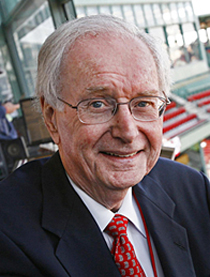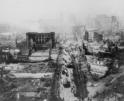
Culture
Branch Rickey, always a step ahead of the competition, had snookered the rest of the league once again.

Flavin
Time for a bit of ancient baseball history, mixed in with a touch of skulduggery and a bushel of bad luck.
In the summer of 1934, a 15-year-old kid snuck into a tryout on the St. Louis Cardinals held at their home field, Sportsman's Park. The kid was too young to participate legitimately since the Cardinals couldn't have signed him to a player contract at his age. At the tryout, he outran and out-threw all the other 800 participants, but he left crestfallen when no one from the Cardinals even approached him. Later, though, Cardinals GM Branch Rickey sent scout Charlie Barrett to pay a call on the kid and his parents to explain that he hadn't been approached because, being only a sophomore in high school, the team couldn't sign him to a contract, and because the Cardinals did not want to draw the attention of other teams to the youngster.
But, Barrett went on to explain, there was no rule saying the Cardinals could not hire the kid as a driver. So it was that Pete Reiser became Charlie Barrett's chauffeur, driving him as he made his rounds of the various Cardinals' minor league facilities. At each stop, he got the opportunity to work out with the local team. The Cardinals were thus able to shield Reiser from the view of other teams while, at the same time, work him out against professional competition. Finally, when he graduated from high school in 1937, he was signed by St. Louis and sent to their affiliate in Superior, Wisconsin. Branch Rickey, always a step ahead of the competition, had snookered the rest of the league once again.
Rickey was soon to get his comeuppance, though. In 1938, Commissioner Kenesaw Mountain Landis decreed that the Cardinals farm system, devised by Rickey, was so successful and extensive that it had become a detriment to other teams, so he declared that 73 of the St. Louis minor leaguers were, in effect, free agents. Among them was Pete Reiser, the one prospect Rickey least wanted to lose.
Resorting to some chicanery, he called his friend Larry MacPhail, who ran the Brooklyn Dodgers, and got him to agree to sign Reiser and to keep him hidden in Class D ball for a couple of years, then deal him back to St. Louis.
It was never divulged what the Dodgers end of the under-the-table deal was, but it bears noting that, shortly later, the Cardinals shipped their Hall of Fame left fielder, Joe Medwick, to Brooklyn for cash, a few lesser-known players, and a player to be named later. It was, on the face of it, a one-sided deal, which was very uncharacteristic of Rickey. But it's believed that Pete Reiser was to be the player to be named later.
In spring training of 1939, the Dodgers player/manager, Leo Durocher, decided to take a few days off from playing in the field and told Reiser, still an unknown minor leaguer, to fill in at shortstop for him. Reiser, in three games and 11 plate appearances, had three home runs, three singles, and three walks. Also, he fielded his position superbly. Durocher raved about his new find to reporters covering the team.
When Rickey heard about all the fuss over Reiser, he called MacPhail and accused him of reneging on the arrangement of keeping Reiser hidden in the low minors. MacPhail, in turn, called Durocher and instructed him to send Reiser back down. Durocher, unaware of the illegal scheme Rickey and MacPhail had cooked up, refused. The two had a monumental blowout, which resulted in Durocher being fired, then rehired, and Reiser ultimately being sent down to Elmira.
But the secret was out. Everyone now knew about Pete Reiser and his unique talent. Branch Rickey's hush-hush deal with the Dodgers was dead.
That year, while playing for Elmira, Reiser broke his throwing arm and had to have bone chips removed from his elbow. The result was that he missed most of the season and was moved from his natural position of shortstop to centerfield, a bad omen.
He started the next year, 1940, at Elmira, was soon promoted to Montreal and, later in the year, was called up to the big team in Brooklyn, where he performed well as a reserve.
In 1941, still only 22 years of age, he started the year as the Dodgers' center fielder and was an immediate sensation. He led the National League in hitting with an average of .343, and also led the league in runs, doubles, triples, and slugging percentage. His fielding was spectacular; he had a cannon for an arm and used his elite speed to fearlessly chase down every ball hit his way. It was that fearlessness, though, that would be his undoing.
In 1942, he was even better than before, hitting .356 in the middle of July. Then, on July 19, in the 11th inning of a tie game between the league-leading Dodgers and their closest competitors, the Cardinals, Enos Slaughter hit a long drive to deep centerfield. Reiser, racing back at full speed, reached up and snagged it an instant before slamming face-first into the concrete wall. The ball was jarred loose from his glove, but he somehow was able to retrieve it and throw it back to the infield, though not in time to prevent an inside the park home run by the speedy Slaughter. Reiser, meanwhile, collapsed unconscious with a fractured skull and a separated shoulder. Durocher, his big-league mentor, rushed to his side. When he saw the extent of Reiser's injuries, Durocher, a renowned baseball tough guy (it was he who coined the phrase, "nice guys finish last"), broke down weeping.
Reiser, still unconscious, was carried from the field and did not come until the next morning. The Cardinals' doctor examined him and recommended he be shut down for the season, but, in the days before the long-term effects of concussions were known, he was, amazingly, back in the lineup only five days later.
But he'd never be the same again.
Suffering from dizzy spells, he slumped badly for the rest of 1942, as the Cardinals passed the Dodgers to win the pennant. The pain in his shoulder resulted in a hitch in his swing and robbed him of all his power. His arm was no longer as strong. A broken ankle and a series of other injuries took away his speed. To top it off, he kept crashing into outfield walls, being taken from the field in a stretcher eleven different times over his career.
How good was he before all the injuries took their toll? Willie Mays, who is generally considered to be the best all around player of the last 75 years, was also mentored by Leo Durocher. In his memoir, Durocher claimed that Reiser was faster, had more power, and threw as well as Mays. Pete, said Durocher, had everything Willie had -- except luck.
- Dick Flavin is a New York Times bestselling author; the Boston Red Sox "Poet Laureate" and The Pilot's recently minted Sports' columnist.
Recent articles in the Culture & Events section
-
The example of the Good ShepherdMichael Reardon
-
Spring Celebration Gala will honor Cardinal O'MalleyShannon Lyons
-
Scripture Reflection for April 28, 2024, Fifth Sunday of EasterDeacon Greg Kandra
-
Boston and the nation respond to the San Francisco Earthquake of 1906Thomas Lester
-
See you in the storyLaura Kelly Fanucci


















